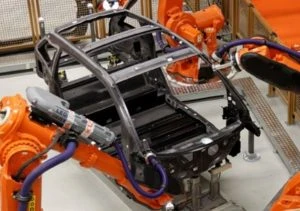Carbon Fibre’s use in Cars
It may come as no surprise to you that the amazingly strong and lightweight material – carbon fibre – has been used in some of the high-end sports cars and racing cars. Cars like the Koenigsegg Agera, the McLaren Senna, Porsche’s 918 Spyder, the Ferrari LaFerrari, Alfa Romeo’s 4C, and BMW’s i8 use a carbon-fibre monocoque body shell in their design. Even BMW’s recent i3 EV city car boasts a carbon-fibre monocoque cell.

BMW i3
Of course, there are many pieces that make up a car’s whole, many of which there are components which can also be made up of carbon fibre, and these are actually more prevalent in different forms and measures throughout the motoring industry, particularly in high-end luxury cars. In some of BMW’s and Porsche’s latest premium cars, carbon fibre has been introduced in various arrangements within the vehicles’ body components. Obviously, the rarer the part, then it will have quite an expensive price tag attached.
Then there are multiple smaller workshops and larger businesses dedicated to creating special automobile parts and designs made from the composite material carbon fibre. Some of these components might be a certain air diffuser or spoiler to make the car look more aggressive or more aerodynamic. Some of these businesses even make carbon fibre interior wraps with a distinctive pattern to make an individual’s car stand out from the crowd.
So, what is carbon fibre?
A quick science lesson first to help us understand: Carbon is number six on the periodic table, and so the carbon atom consists of 6 protons, 6 neutrons, and 6 electrons. Two of the 6 electrons fill up an electron shell close to the carbon atom’s nucleus, while the other four electrons sit in a half empty electron shell around the outside. These electrons running about on the outside shell are known as valence electrons and are the key to carbon’s amazing and incredible properties. Any electrons in an atom’s outer shell are involved in taking part in forming chemical bonds. How many bonds these electrons are involved with depend on how much room there is in the outside shell. What makes carbon so amazing is that it has got space for four other electrons to make its outer shell full. This attribute makes carbon a four-way connector that can link atoms together.
A polymer is any material that is made of long, repeating chains of molecules. So, carbon can build up straight chains of carbon atoms, carbon chains with branches, and even carbon chains that are joined end to end to make loops! So, a carbon polymer is made up of chains and chains of carbon molecules that are linked up in a scaffolding-type structure. Carbon can bond to itself, but, when it doesn’t, the end of the carbon chains can terminate with other elemental atoms. For example, a carbon chain can finish up with a small hydrogen atom, which makes these chains slippery like in oils. Carbon chains can also connect to other groups of elements, making them a specific ‘functional group’, each group having a different chemical property.
Graphite is a crystalline form of the carbon element. Individual layers of graphite are some of the strongest structures that we know about in the universe. Carbon fibre material is made up of individual layers of graphite, which on their own are quite slippery. Carbon-fibre-reinforced polymer (CFRP) composites (also known as carbon-fibre laminates) are made up of woven layers of nearly pure carbon fibres that are bonded together by a hardened plastic like an epoxy resin. CFRP composites are therefore extremely strong and stiff.
A stretched carbon fibre is up to five times the strength of steel, as durable as steel, but only a quarter of steel’s density. Being this strong and much less dense than steel makes carbon fibre a lighter and stronger material than steel. On top of being extremely strong and lightweight, carbon fibre is also high in chemical resistance, has a high stiffness, has low thermal expansion, has a low weight to strength ratio, and is tolerant of excessive heat. These are the reasons why carbon fibre is so sought after in the motor racing arena and in high-grade luxury sports vehicles? These amazing properties make carbon fibre a very popular material for use in aerospace, military, recreational, as well as in automotive industry applications.
As CFRPs become more readily available, the trickle down effect will see it being more and more a part of a new mainstream motor vehicle, EVs included.